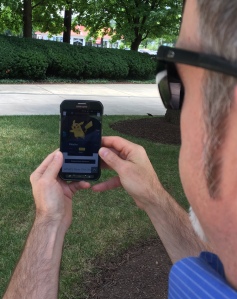Prema Chandrathil
Public Affairs Officer
NRC Region III
The highly popular cellphone game has found its way to a U.S. commercial nuclear power plant.
 The Pokémon Go game lets users chase and catch virtual creatures with their cellphone cameras. However, Pokémon Go and other games that use the GPS signals in our phones are creating safety and security issues. Local law enforcement officials across the country have cautioned folks to pay attention while playing and be careful not to wander into traffic (warnings that have not always been heeded). The phrase “heads up” takes on new meaning here.
The Pokémon Go game lets users chase and catch virtual creatures with their cellphone cameras. However, Pokémon Go and other games that use the GPS signals in our phones are creating safety and security issues. Local law enforcement officials across the country have cautioned folks to pay attention while playing and be careful not to wander into traffic (warnings that have not always been heeded). The phrase “heads up” takes on new meaning here.
The games have even enticed players to trespass on private property — including the Perry nuclear power plant in northeastern Ohio.
Recently, three teenagers pursued one of the strange looking cartoon creatures into the employee parking lot of the Perry plant, at 3 in the morning! Instead of catching the Pokémon, they were caught by security officers and escorted off the property.
But it could have ended very differently – and much more seriously — for these Pokémon pursuers.
Commercial nuclear plants are among the best-protected facilities in the country. Their security officers are highly trained professionals who carry guns and are authorized to use them in protecting the plant. Though you might not always see the protective measures and many details are not publically available, security is in place. (Click here for more info on the NRC’s security requirements for nuclear power plants.)
So have fun exploring and climbing over rocks searching for those virtual creatures, but the bottom line is be safe while playing these games. A nuclear power plant is not the place to be searching for Pikachu.

Gotta Nuke’em All. Be careful playing this game.
I didn’t played this game yet but i must say hats off to that guy who invented this idea, this game getting lot of trends now.
Stay safe while catching em all!
Very informative article!
Well done guys 🙂 Kudos to the developer of (the game) …I can’t believe its everywhere now.
Note: A link removed per the blog comment guidelines
My Bro Anon, you just can’t be topped. So glad to have you aboard.
Pit Bull : Haven’t you studied “Power Plant Engineering 101” build and sell “Power at-Load-Center” for the them best dollars, who cares for “safety or obeying EPZ Rules?”. It is all bout K street and lobbying for maximum Dough, Bro !
P.S. So Prema, what is up for NRC, next wring Pokeman-No-Go Impact Rule hey (Like AIA Rule)??
A similar warning should be made to nuclear plant workers and the general public about other GPS-based, cellphone and “geo-caching” games such as Ingress. I am aware of four Ingress portals (physical landmarks that players must be in close proximity to in order to perform most Ingress actions) that are near a nuclear power plant site in New England. While these portals are far enough away from the plant’s fence line that players should not be tempted to trespass onto the site, players need to know that Plant Security Organizations do monitor the surroundings of a nuclear power plant and do investigate anyone observed using any type of handheld device while on the property. The key point is to always be aware of your surroundings when you are playing these types of games.
Why Do Nukes Have the Best Security?
Good point NRC. Don’t go “poking” in the wrong places. But really nothing to fear if you accidentally stumble onto nuke plant property. As we know you would be much safer there than other places Pikachu might lead you. Perhaps including places where you may be robbed or worse.
I agree w the NRC that nuke plants have some of the best security of any place in our country or in the world for that matter. And that security is very appropriate. A successful attack on a nuke plant from the air, water, or land would have devastating consequences. The consequences would certainly exceed those of another Three Mile Island accident & could easily approach those of a Chernobyl or Fukushima disaster. And think of that happening at a nuke plant in the backyard of a major US city. I certainly think of the Indian Point units around 25 miles from downtown New York City. But there are unfortunately many other nukes close to a lot of folks. Even Watts Bar, the newest nuke being brought on line, has around 2 million people living within 50 miles of the plant.
Long ago the NRC gave up on one of its founding safety principles even though it is still on the books i.e. still a regulatory requirement of 10 CFR Part 100.
In Section 100.1(d), the regulation states this on defense-in-depth with regard to siting:
“The Commission intends to carry out a traditional defense-in-depth approach with regard to reactor siting to ensure public safety. Siting away from densely populated centers has been and will continue to be an important factor in evaluating applications for site approval.”
Of course the NRC expects all its licensees to abide by the law but obviously considers itself to be above that same law.
Well done guys. Well written and an excellent way of communicating to public AND employees. I served with NRC from 1975 to 2004, then as a consultant to NSIR until 2007. I was a Physical Security Specialist, Safeguards Section/Branch Chief and was a member of the Chairman’s review of NRC Safeguards in 2001. Keep up the good work.